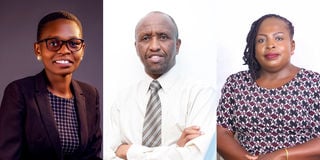World Teachers’ Day: Why we worry more about learners than our own challenges

From left: Brema Oyalo, deputy principal at Shieywe Secondary School in Kakamega County, the Executive Head at Makini Schools Wilson Mwangi, and Josephine Lukote, a Junior Secondary School (JSS) teacher at St. Teresa Isanjiro in Kakamega.
The World Teachers’ Day will be marked today to celebrate the successes that teachers have achieved in the noble profession.
Teaching is more than just a profession for those who have chosen this career path — it is a passion. A labour of love. Teachers are required to nurture the potential in learners even when faced with daunting challenges.
Ahead of today’s celebrations, the Nation spoke to a number of teachers and the majority said that they are more concerned about the well-being of schoolchildren than their own challenges.
“You sometimes feel guilty knowing you have not helped a child the way you wanted. You can see the child has a problem but you cannot help them because of limited time,” said Josephine Lukote, a Junior Secondary School (JSS) teacher at St. Teresa Isanjiro in Kakamega County.
Like many other teachers across the country, Ms Lukote struggles to give individualised attention to her students. She teaches many students and barely has time to interact keenly with each of them.
The theme of this year’s World Teachers’ Day is; "The teachers we need for the education we want: The global imperative to reverse the teacher shortage." The theme is centred on the lack of enough teachers which is one of the main concerns for teachers across the country.
Ms Lukote teaches nine different subjects, and not the recommended two that she had trained for. There is a shortage of teachers and as a result, members of staff are called upon to step in and take up more subjects.
At St. Teresa Isanjiro there are 200 students and eight teachers in JSS; each class has an average of 50 students.
Ms Lukote said that the high number of students limits student-teacher connection which results in weaker students lagging behind.
“The JSS is still new, students are in need of more teacher contact and therefore when teachers are barely available for the students, it ends up affecting the learners,” she noted.
The Teachers Service Commission (TSC) hired 30,550 teachers specifically for JSS so that each class has one teacher. However, that has not solved the problem of the shortage of teachers as the number of students remains high.
The teacher-student ratio in Kenya is a critical factor that impacts the quality of education. According to the Basic Education Statistical Booklet 2020, the current recommended teacher-student ratio is 1:25 for pre-primary schools, 1:40 for primary schools and 1:35 for secondary schools. But that is not the case in some parts of the country which are dealing with a teacher-student ratio of as high as 1:70.
Johnson Nzioka, the National Chairperson of the Kenya Primary Schools Head Teachers Association (Kepsha), while acknowledging the persistent challenge of achieving the ideal teacher-to-learner ratio, commends the government's newfound commitment to addressing this issue by employing more teachers.

Kenya Primary Schools Head Teachers Association Chairperson Johnson Nzioka (centre) and Vice-Chairperson Fuad Ali (in cap).
“While we haven't quite reached the ideal teacher-to-learner ratio, there is a palpable sense of progress. The government is now actively working to bridge this gap by hiring more teachers, a commitment we haven't seen in the past. We genuinely appreciate these efforts and believe that we are steadily moving closer to achieving that desired ratio. In the not-so-distant future, we hope to see this vision become a reality,” said Mr Nzioka.
However, he highlighted the concern raised by Ms Lukote.
Mr Nzioka said that it is not just about the ratio; it's about the specialisation of the teachers being recruited.
He lamented that there is an overabundance of English, Kiswahili, Social Studies, and CRE teachers and a scarcity of teachers in subjects such as Science, Mathematics, and Performing Arts.
“Regrettably, we find ourselves in a situation where the Arts are well-represented, but the Sciences and performing arts are in perilous scarcity. To paint a more vivid picture, there are schools that don't even have a single teacher in these crucial subjects. This dire situation calls for a specific and strategic approach,” he added.
For years, Kenya has grappled with a persistent and growing shortage of teachers. With a rapidly increasing student population and limited resources, educational institutions across the country are struggling to provide quality education.
TSC in its Strategic Plan 2023-2027 notes that the number of registered teachers has grown from 37,000 in 1967 to 901,770 as at June 2023.
To ensure the successful implementation of the Competency Based Curriculum, the Commission said it has retooled 229,000 primary school teachers and 55,125 teachers for JSS.
But despite all the efforts, the number of teachers needed to bridge the gap remains high with the TSC annual report showing that schools need an extra 111,870 tutors.
The main challenge to getting teachers employed is money, as the commission said that it needs Sh14.8 billion to recruit more teachers.
In June, Education Cabinet Secretary Ezekiel Machogu announced that the government would hire 25,000 teachers in the current financial year which started in July.
The problem of teacher shortage also stretches to secondary schools with data from the Economic Survey 2023 showing that as of 2022, there were 124,992 teachers in public secondary schools across the country teaching more than 3.8 million learners.
Brema Oyalo, a deputy principal at Shieywe Secondary School in Kakamega County, said that her school has an average of 55 students in one class. This is still above the recommended United Nations Educational, Scientific and Cultural Organization (Unesco) ratio of one teacher to 25 students.
Ms Oyalo noted that the biggest challenge teachers deal with is increased workload which sometimes affects their efficiency resulting in burnout.
“The recommended number of lessons by TSC that a teacher should teach is 27 lessons per week but sometimes teachers end up teaching 35 lessons,” she said.
This leaves teachers with so much work and less time to give individual attention to learners, she noted.
Also Read: Scourge of private schools in Nairobi slums
Ms Oyalo, however, said that the teachers’ employer has stepped in to help schools dealing with shortage of manpower by hiring teachers on contract and supporting schools in paying teachers employed by the board of management.
Private schools, however, hardly have to deal with the problem of persistent shortage of teachers. Many of the schools are well-equipped and are can afford to hire enough teachers.
Wilson Mwangi, the Executive Head at Makini Schools, said that learners are well catered for and the institution has enough teachers.
“We have a small size of students in each class and this helps teachers to give equal attention to each learner,” he said.
But inside the crowded classrooms at Ms Lokote’s school, the life of a teacher is relentless, with each teacher handling a load of 10 lessons a day. For students navigating 14 different subjects, the struggle to keep pace is real. Fatigue sets in by noon, leaving little energy to assist struggling learners, especially in JSS where students need more teacher guidance than ever.
But these dedicated educators push on. Trained primarily for two subjects, they now find themselves teaching a multitude of others out of necessity. It's a testament to their commitment that they endeavour to ensure no child misses out on their education.
Yet, the burden takes its toll. There's no extra pay to compensate for the extra subjects taught. It's not just physically straining; it's emotionally taxing too. The teachers carry a heavy sense of guilt for not being able to help each child as much as they'd like. They see the struggles, but time is a luxury they cannot afford.
The call for help is clear. The teachers, the students, and the school itself yearn for a solution. Early disbursement of capitation from the government could pave the way for hiring more teachers through the board of management. It's a simple equation: more teachers, more individual attention, and brighter futures for the students.
In a country where education is free and enrolment is surging, the need for financial support is greater than ever.
The teachers remain hopeful that their plea will be heard, that more resources will be allocated, and hope for a day when they can provide that extra bit of support, where no child is left behind, and where their profession can flourish as it should.






